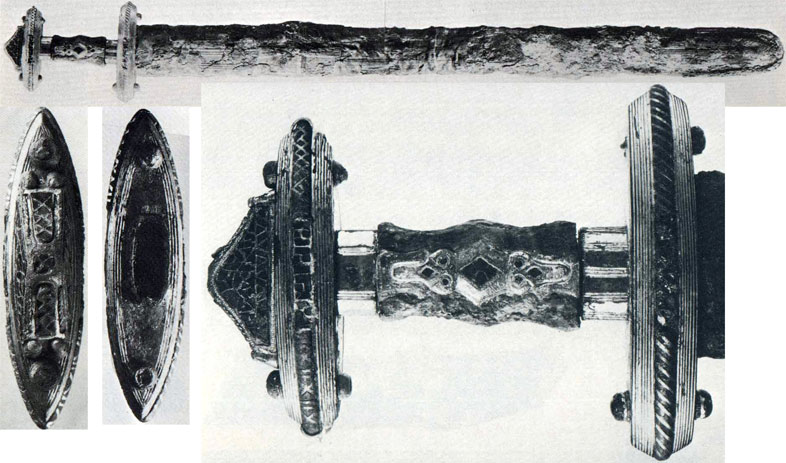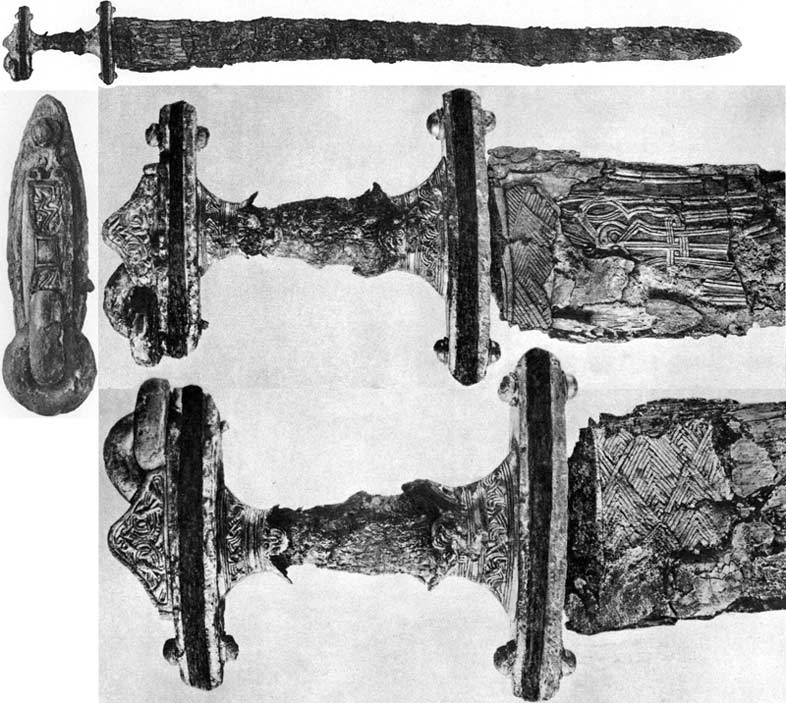You know how it is, you can always find things when you don't want them, and can never find them when you Do want them.
I was looking at some really nice migration hilts recently, and now I can't find them!
Was wanting to make one, and needed some details.
If anyone can help It'd be greatly appreciated!...or pointers in the right direction...
All best,
Richard.
Try Jeroen's museum photos...
http://1501bc.com/page/index2.html
This one is a favorite of mine...(from National Museum in Kopenhagen)[ Linked Image ]
http://1501bc.com/page/index2.html
This one is a favorite of mine...(from National Museum in Kopenhagen)[ Linked Image ]
| Richard Hare wrote: |
| You know how it is, you can always find things when you don't want them, and can never find them when you Do want them.
I was looking at some really nice migration hilts recently, and now I can't find them! Was wanting to make one, and needed some details. If anyone can help It'd be greatly appreciated!...or pointers in the right direction... All best, Richard. |
Any descriptions? There are quite a lot of different ones :)
G Ezell,
Jeroen,
You have both been a great help already!
The pic you attached is brilliant! G..... I have not seen that hilt before, and the Llink to Jeroen's photographs is a wonderful place to explore.
Jeroen,
I've found pictures of Valgard hilts, but am just wondering what other wondeful examples are out there.
(Also have pic of the Dybak sword.)
On one of the Valsgard hilts, Can anyone tll me what the "organic" layer is in the hilt and guard?
Please see attachment.
Thank you for your help!
Richard.
 Attachment: 97.78 KB
Attachment: 97.78 KB

Jeroen,
You have both been a great help already!
The pic you attached is brilliant! G..... I have not seen that hilt before, and the Llink to Jeroen's photographs is a wonderful place to explore.
Jeroen,
I've found pictures of Valgard hilts, but am just wondering what other wondeful examples are out there.
(Also have pic of the Dybak sword.)
On one of the Valsgard hilts, Can anyone tll me what the "organic" layer is in the hilt and guard?
Please see attachment.
Thank you for your help!
Richard.

The only organic parts of this Valsgärde sword is the mid portion of the grip. Otherwise it is gilt and silvered bronze, cast hollow and in several parts for each component. Niello and garnets are used for embellishment.
-I do not remember if the mid layer of upper and lower guard is iron with silver inlay or bronze.
Personal impression after seeing the original: I think the wood part of the grip was leather covered originally.
-I do not remember if the mid layer of upper and lower guard is iron with silver inlay or bronze.
Personal impression after seeing the original: I think the wood part of the grip was leather covered originally.
The only organic parts of this Valsgärde sword is the mid portion of the grip. Otherwise it is gilt and silvered bronze, cast hollow and in several parts for each component. Niello and garnets are used for embellishment.
Personal impression after seeing the original: I think the wood part of the grip was leather covered originally.
Personal impression after seeing the original: I think the wood part of the grip was leather covered originally.
Thank you Peter,
The mid layer is what was foxing me a bit., I didn't know if it was horn/silver, but figured it must be something else, as it would be much more degraded if horn.
Interesting that the grip was probably leather covered, normally little survives to tell us much!
Do you know how the garnet settings were originally made? (Not that I'll be using gold or garnets !!)
Were the settings soldered?
Also,could you inform me of the material in the mid layer of the attached photo?
Thank you again,and for your time.
Richard.
 Attachment: 99.22 KB
Attachment: 99.22 KB

The mid layer is what was foxing me a bit., I didn't know if it was horn/silver, but figured it must be something else, as it would be much more degraded if horn.
Interesting that the grip was probably leather covered, normally little survives to tell us much!
Do you know how the garnet settings were originally made? (Not that I'll be using gold or garnets !!)
Were the settings soldered?
Also,could you inform me of the material in the mid layer of the attached photo?
Thank you again,and for your time.
Richard.

| Richard Hare wrote: |
| Thank you Peter,
The mid layer is what was foxing me a bit., I didn't know if it was horn/silver, but figured it must be something else, as it would be much more degraded if horn. Interesting that the grip was probably leather covered, normally little survives to tell us much! Do you know how the garnet settings were originally made? (Not that I'll be using gold or garnets !!) Were the settings soldered? Also,could you inform me of the material in the mid layer of the attached photo? Thank you again,and for your time. Richard. |
Richard,
I will have to look this up to give you reliable information.
The leather covering of the grip is my personal impression, not a scientific truth. If I follow his up, there might be information from conservation reports.
Garnets are set in lattice work of thin gold sheet, making mosaic patterns. Otherwise solitary garnets are set like you would any precious stone, I should think: a burnished down lip that holds the stone in place.
My first guess is that the mid layer of the second sword you posted is organic. I could not tell if it is wood or horn.
I shall see if I can find some more detailed information on these.
I base my idea of leather covered wooden grips on the fact that the fine scabbards, when they are preserved show beautiful carving in the wood and a thin cover of leather, that lets the carving show through. The seaxes that are found with these swords also have leather covered scabbards and grips with wooden cores. It seems to be a common practice in the cutlery craft of this period to cover wood with leather. I would not expect to dee bone or horn covered with leather, as those materials are more resilient and water resistant by their own nature.
Thank you for this information, Peter.
The way you describe the sax hilts and sword scabbards, the leather sounds very plausable.
Any firther information you turn up would be most appreciated, but please do not put yourself out.
At present my head is swimming with different hilts I'd like to have a go at...but only have one blade to work with!
Thank you again,
Richard.
The way you describe the sax hilts and sword scabbards, the leather sounds very plausable.
Any firther information you turn up would be most appreciated, but please do not put yourself out.
At present my head is swimming with different hilts I'd like to have a go at...but only have one blade to work with!
Thank you again,
Richard.
Page 1 of 1
You cannot post new topics in this forumYou cannot reply to topics in this forum
You cannot edit your posts in this forum
You cannot delete your posts in this forum
You cannot vote in polls in this forum
You cannot attach files in this forum
You can download files in this forum
All contents © Copyright 2003-2006 myArmoury.com — All rights reserved
Discussion forums powered by phpBB © The phpBB Group
Switch to the Full-featured Version of the forum
Discussion forums powered by phpBB © The phpBB Group
Switch to the Full-featured Version of the forum